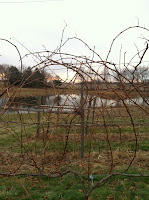It got warmer – even 41°F seemed balmy enough to work in the vineyard all morning. We nearly finished the Chambourcin patch #1 with basic pruning and if it would not have been for the gusty wind, we would have gotten even further. Instead we started pruning the upper blackberry patch, which we never finished last fall – this is our newer, not yet bearing, patch of Triple Crown berries. Hopefully, we can get ahead of the weeds by starting early. Unfortunately, half of this patch was still snow covered and the ground was frozen so hard, that we could not get all the weeds out – so the pruning was limited to certain sections of the patch.
 And – we started our first seeds: Bell Pepper, one seed packet of a mixed variety (that did really well last year), and a second packet of just red roasting peppers. Probably should have started these a week or two ago, so I am hopeful that they will get strong enough by mid May to plant outside. Also started some Marigolds, just for fun! It is so nice to see flats of seeds on the windowsills.
And – we started our first seeds: Bell Pepper, one seed packet of a mixed variety (that did really well last year), and a second packet of just red roasting peppers. Probably should have started these a week or two ago, so I am hopeful that they will get strong enough by mid May to plant outside. Also started some Marigolds, just for fun! It is so nice to see flats of seeds on the windowsills.

















